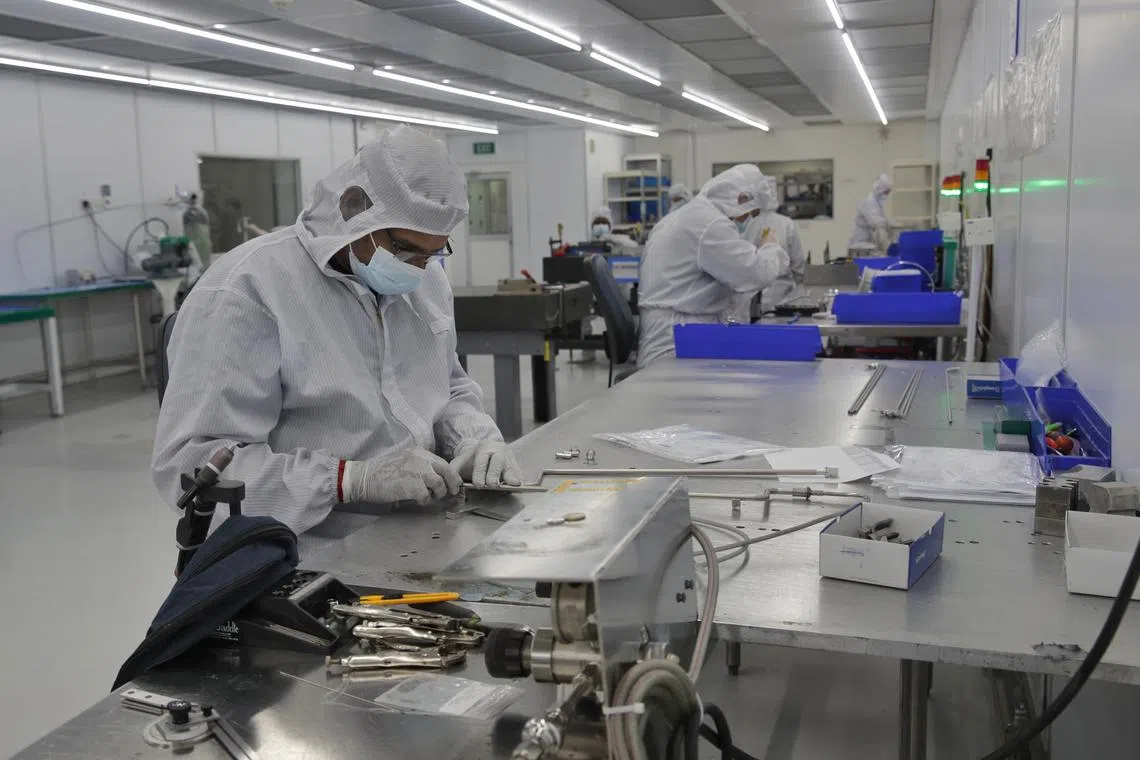Singapore’s factory activity contracts for second straight month
Sign up now: Get ST's newsletters delivered to your inbox

The electronics sector PMI recorded a decline of 0.3 point from the previous month to post a further contraction at 49.1.
ST FILE PHOTO
Follow topic:
SINGAPORE - October’s factory activity contracted for the second consecutive month while the electronics sector pulled back for the third straight month, suggesting a continued deterioration in momentum, outlook and confidence in the last quarter of 2022.
Noting that this was unsurprising, analysts said they expect further weakness in the coming months.
Singapore’s overall purchasing managers’ index (PMI) fell to 49.7, 0.2 point below September’s. October became the second consecutive month of contraction in overall activity for the manufacturing sector after having expanded for 26 straight months. This was attributed to a faster contraction in the key indexes of new orders, factory output and inventory.
Meanwhile, the electronics sector PMI recorded a decline of 0.3 point from the previous month to post a further contraction at 49.1. This was the lowest reading since June 2020 (47.6), and was the third contraction in a row after two years of continuous expansion.
PMI is an indicator of business activity and is considered to be a good leading indicator of economic activity. A PMI reading above 50 indicates expansion, while one below signals contraction. The index is compiled and published by the Singapore Institute of Purchasing and Materials Management (SIPMM).
UOB senior economist Alvin Liew said the further slip of the electronics sector PMI into contraction territory has strengthened the view that an electronics down cycle is under way. He also noted that Singapore’s PMI is similar to the October PMIs in economies with significant exposure to electronics manufacturing such as South Korea (48.2) and Taiwan (41.5).
“Even as we continue to be cautiously positive on the outlook for some manufacturing sectors in Singapore, such as the areas of transport engineering, general manufacturing and precision engineering, we see that worsening electronics performance and increasingly weaker demand from North Asian economies, especially China, are clearly weighing negatively on export momentum and manufacturing demand,” he added.
The electronics sector makes up 40 per cent of Singapore’s industrial output.
DBS senior economist Irvin Seah said the electronics sector has turned from a driver to a drag for the Singapore economy and expects weaker global demand to continue. Instead, the services sector may turn from a drag to a support for the Singapore economy with the removal of Covid-19 restrictions, he added.
Ms Sophia Poh, vice-president of industry engagement and development at SIPMM, said: “Global economic headwinds arising from the macroeconomic risks of high inflation and geopolitical uncertainties have continued into the final quarter of this year.
“These uncertainties in the global trade environment coupled with mounting cost pressures are weighing on demand despite the year-end festive season, and local manufacturers, in particular, the electronics sector, have been scaling back investment plans.”

Noting the fairly bearish sentiments in the months to come, Ms Selena Ling, chief economist at OCBC Bank, said: “It would not surprise me if the manufacturing and electronics PMIs continue to slide for the remaining months of 2022 despite the upcoming year-end peak festive season, and for the manufacturing sector to contract in 4Q22.”
“Headwinds include heightened recession risks in the major economies, continued inflation and consequently global monetary policy tightening, geopolitical tensions, which include the US chip export ban on China, and cooling end-consumer demand for electronic products,” she added.
Mr Liew said: “Despite the weaker 2022 manufacturing growth, we are retaining our 2022 GDP growth forecast unchanged at 3.5 per cent as we see the upside surprise from services activities, due to strong pipeline of activities post-reopening of the economy... But with the faltering 2023 manufacturing outlook, we expect GDP growth to ease noticeably to 0.7 per cent in 2023.”


